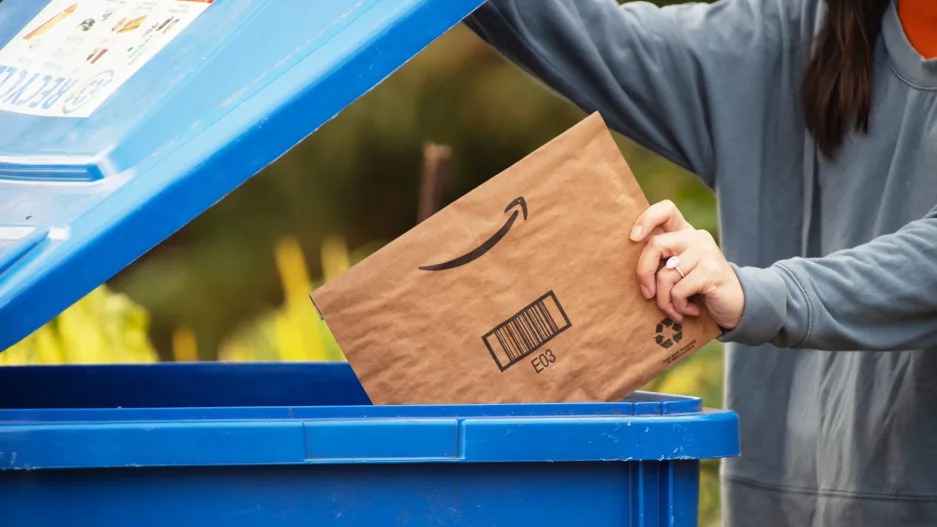- | 8:00 am
Amazon is trying to shrink its single-use plastic. It’s kind of working
Amazon is taking small steps to use less plastic packaging. And because of its massive size, even those matter.

Last year, even as the number of Amazon orders grew, the e-commerce giant managed to shrink its plastic footprint. The amount of single-use plastic that it used in shipping dropped by 11.6% from 2021 to 2022, the company said in a sustainability report this week. That meant eliminating around 25 million pounds of plastic.
It’s the latest step as the company tries to tackle the massive amount of packaging it uses. To reduce cardboard, Amazon uses machine-learning software to analyze each item in an order so it can choose the best packaging to protect products with as little material as possible.
In some cases, it eliminates outside packaging completely. Last year, 11% of packages were delivered in a category the company calls SIOC, or “ships in own container.” That includes everything from paper towels to TVs to some products in bags, like clothing and bedsheets. The company tests each product to make sure it can arrive undamaged without an outside box. Other machine learning algorithms help identify products that could safely ship on their own if brands make small adjustments, such as removing cutouts in packaging that are used to display products on retail shelves.

Over the past few years, the company has relied on padded mailing envelopes rather than boxes to help reduce cardboard (and use less fuel, since more packages can fit on a single truck, with less weight). But that also has meant using more plastic bubble mailers that can’t readily be recycled. Now Amazon says it’s starting to phase out at least some of those in favor of lightweight paper mailers—designed by its team internally—that can be dropped in curbside recycling bins along with cardboard boxes.
It’s not clear how far the company is taking this effort. The sustainability report talks about getting rid of “padded bags containing plastics in favor of recyclable alternatives,” but Amazon hasn’t explicitly said that the plan includes eliminating every type of plastic mailer. There are hints that it might not. Its paper mailers were designed to replace mixed-material packages (with paper outside and plastic bubbles inside), which the company says aren’t recyclable; Amazon has eliminated 99% of these mixed-material mailers in the U.S. and Canada.
The company also highlights the fact that its fully plastic blue-and-white mailers can be recycled—something that most people probably don’t do in practice since the mailers can’t go in standard recycling bins but rather have to be dropped off at certain locations.
In Europe, the company has eliminated single-use plastic bags in shipments from local fulfillment centers, along with single-use plastic air pillows. Still, that move is “essentially about complying with EU regulations,” says Alexis Normand, cofounder and CEO of the carbon accounting platform Greenly. The EU’s directive on single-use plastic bans items like plastic bags and other single-use plastic packaging.
Amazon told Fast Company on background that it considers “numerous factors” for packaging—including the customer experience, protection for products, weight, recyclability, and how easily the packaging can be procured—but didn’t comment on the role that regulations play. It also didn’t say when (or if) plastic bags and pillows would be phased out in the U.S.

Normand says Amazon could do more to help shrink plastic use from third-party sellers. “One approach could involve incentivizing these sellers to reduce their plastic usage—for example, by offering preferential rates or taking smaller profit margins when sellers achieve specific plastic-reduction goals,” he says. “Additionally, highlighting and promoting best-practice sellers on the website would encourage others to follow suit.”
There’s still a very long way to go: Amazon reported that it used 85,916 metric tons of single-use plastic in its fulfillment centers globally last year, an amount roughly three and a half times heavier than the Statue of Liberty. At the same time, because of that massive scale, each small step forward matters.
“Amazon’s reduction in plastic use is good news for the oceans,” says Matt Littlejohn, senior vice president of the nonprofit Oceana, which has previously calculated how much Amazon plastic packaging may be ending up in the ocean. “As a next step, the company should make a global commitment to move away from single-use plastic packaging.”






































